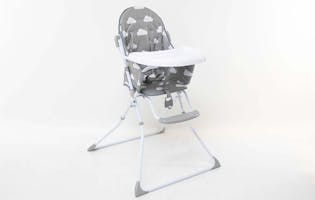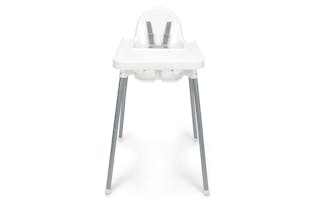High chairs
Find the best high chair with our buying guide and test results for 16 new and 8 discontinued models.
Safety is more important than style, so we test high chairs against the Australian standard.
But from flying food, smears and mess, you also want one that’s easy to clean. So we mess them up with Weet-Bix and milk, spaghetti and tomato sauce and baby food.
Safety first
The most common form of injury involving high chairs is when a child falls after trying to stand up in, climb in to or get out of the chair. Other serious injuries can result from having their fingers, toes or limbs pinched or crushed by moving parts or gaps, or choking on easily detachable small parts.
Safety tip: When you get home, make sure you set up the chair at least half a metre from anything your child could use to push off from and topple over – windows, large furniture, blind or light pullcords, and so on.
What to look for
Safety standard
Look for chairs that comply with the Australian Standard for high chairs, AS 4684:2009 or the European Standard EN14988. In New Zealand these standards are voluntary.
Tray
This should be secure when fitted but easy for you to remove and adjust. A removable tray insert is useful – it fits on top of the tray and is easily taken out for cleaning. A cupholder helps prevent spills.
Footrest
This is important to support an older child’s feet or calves. Adjustable footrests are useful as a child grows.
Reclining seat
This is handy for babies who can’t sit upright for long. But (except for bottle feeding) don’t have the seat in its reclining position while you’re feeding the baby – it’s a choking hazard.
Seat cover
This should be easy to wipe clean. A removable one is a plus.
Stability
Legs should taper outwards, preferably extending further than all other parts of the chair.
5-point harness
This has a crotch, waist and shoulder straps so kids can’t fall or climb out. Shoulder straps that attach to the seat at shoulder height provide more effective restraint than ones that attach to the back of the waist strap. The crotch strap should be anchored close enough to the back that the child can’t slip through one side. The buckles should be easy for you, but not your child, to release. Ideally, the harness should be non-removable, or at least require a tool to remove it (such as undoing a screw), so you or your child are unlikely to take it off and lose it, or forget to reattach it.
Castor wheels
These are handy for moving the chair around. There should be brakes on at least 2 wheels: older children may be tempted to take the baby for a joyride when your back is turned. If the high chair doesn’t have castors check it’s light enough to move easily (without its passenger).
Construction
The chair should be sturdy enough to carry the weight of a child. Push on the seat and backrest to see if they sag, deform, move out of position or collapse.
Safety checks
Check that a child’s finger, toe, arm, leg or head can’t be caught – especially around the arm rests and tray. Moving parts shouldn’t be able to pinch, crush or trap a child’s finger, toe, limb or head (or the fingers of an adult folding or adjusting the chair). Also check for sharp edges and points along the edges of the chair and tray, and easily detachable parts (including stickers) that could pose a choking hazard.
Safety failures
Where a high chair fails a safety test, we rate these failures as major, minor or very minor.
- Major safety failures include those concerning stability, durability, and security of the frame-locking mechanism. When a high chair tips over during the stability test or breaks during durability testing, it automatically earns our Don’t Buy status.
- Minor safety failures can be managed with safe and sensible use. Examples are finger entrapment hazards in a hard to reach area and sharp edges. High chairs with only minor safety issues may be “worth considering” but we don’t give them our full recommendation.
- Very minor safety failures don’t affect our scores but are issues to be aware of so you can limit potential risk. For example, a harness that’s not permanently attached to the chair at the shoulders, waist and crotch points. This is considered a “very minor safety failure” as there’s no obvious risk if you use the high chair as it’s intended with the harness attached.
Portable baby seats
Harnesses, boosters and clip-on toddler and infant seats are compact alternatives to a standard high chair. Here’s what to consider if you like this option.
- Fitting: the seat should fit securely and easily. Most stores (and product websites) have them set up so you can see how they work.
- Security: make sure the seat won’t move, or tip over the table or chair, once it’s attached and your child is in place. Give it a firm tug up, down, sideways, back and forth to make sure it’s anchored securely.
- Seat: the seat should have back and side support, and prevent the child leaning too far and unbalancing or falling. A seat that reclines is useful for seating an infant.
- Tray: if provided, the tray should be secure when fitted but easy to remove, attach and adjust.
- Washable: the chair should be easy to clean.
- Height-adjustable: some portable seats can be adjusted for smaller or larger children.
- Capacity: check the recommended age and weight for the seat suits your child.
We've tested 24 high chairs .
Find the right one for you.
Anko

Anko
